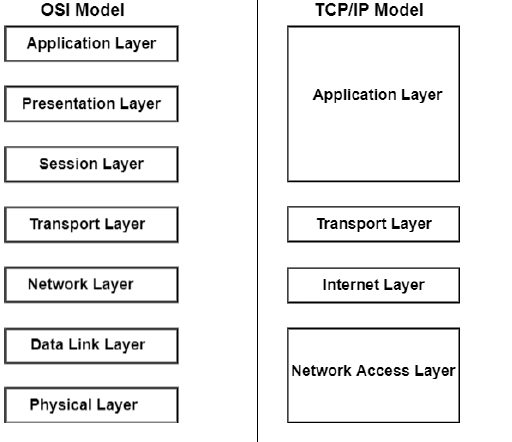
 Data Structure
Data Structure Networking
Networking RDBMS
RDBMS Operating System
Operating System Java
Java MS Excel
MS Excel iOS
iOS HTML
HTML CSS
CSS Android
Android Python
Python C Programming
C Programming C++
C++ C#
C# MongoDB
MongoDB MySQL
MySQL Javascript
Javascript PHP
PHP
- Selected Reading
- UPSC IAS Exams Notes
- Developer's Best Practices
- Questions and Answers
- Effective Resume Writing
- HR Interview Questions
- Computer Glossary
- Who is Who
Difference between OSI and TCP/IP Reference Model
Following are the differences between OSI and TCP/IP Reference Model ?
| OSI | TCP/IP |
|---|---|
| OSI represents Open System Interconnection. | TCP/IP model represents the Transmission Control Protocol / Internet Protocol. |
| OSI is a generic, protocol independent standard. It is acting as an interaction gateway between the network and the final-user. | TCP/IP model depends on standard protocols about which the computer network has created. It is a connection protocol that assigns the network of hosts over the internet. |
| The OSI model was developed first, and then protocols were created to fit the network architecture's needs. | The protocols were created first and then built the TCP/IP model. |
| It provides quality services. | It does not provide quality services. |
| The OSI model represents defines administration, interfaces and conventions. It describes clearly which layer provides services. | It does not mention the services, interfaces, and protocols. |
| The protocols of the OSI model are better unseen and can be returned with another appropriate protocol quickly. | The TCP/IP model protocols are not hidden, and we cannot fit a new protocol stack in it. |
| It is difficult as distinguished to TCP/IP. | It is simpler than OSI. |
| It provides both connection and connectionless oriented transmission in the network layer; however, only connection-oriented transmission in the transport layer. | It provides connectionless transmission in the network layer and supports connecting and connectionless-oriented transmission in the transport layer. |
| It uses a vertical approach. | It uses a horizontal approach. |
| The smallest size of the OSI header is 5 bytes. | The smallest size of the TCP/IP header is 20 bytes. |
| Protocols are unknown in the OSI model and are returned while the technology modifies. | In TCP/IP, returning protocol is not difficult. |


Advertisements
